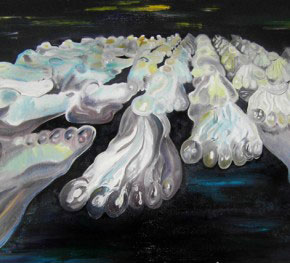Painter's drama born of the desert
Updated: 2013-02-25 14:26
By Mike Peters (China Daily)
|
|||||||||||
 |
|
Fathiya Tahiri's paintings are full of passion. "When I paint, I feel as free as the day I was born," she says. Provided to China Daily |
Fathiya Tahiri's family remembers that she was fascinated by shapes, and their potential to be put together or rearranged, as a small child. At the age of 18, that enthusiasm carried her from Rabat to Paris to study architecture.
|
 |
|
 |
|
 |
But soon her visions came down in scale. While she was developing urban projects around Morocco after she returned home, she became focused on furniture design.
Her sculpture pieces found their way to art exhibitions, and soon she was also creating "sculpture for the body" as a fine jewelry designer.
More recently, sculpture and painting have become her passion, on display at distinguished venues from the Venice Biennale (2005 and 2009) to the Shanghai Art Museum (2011).
"Painting is about now, immediacy, freedom and love," she says ahead of her new show opening next week at the National Art Museum of China. "My life seems to be a permanent cycle where resurrection is the outcome of my paintings. When I paint, I feel as free as the day I was born."
Her approach to sculpture seems a little more grounded: First is the discovery of the right material, she says. Connecting her vision of a piece with the right medium is "like solutions to mathematical equations, and only when an equation is solved do I found out how obvious it was."
Curator Chang Tsong-Zung gets a bit more high falutin - as curators are wont to do - but with compelling effect.
"In Chinese there is a word for a spirit, hun (魂) or ghost, that has not found its embodiment. Hun is a yin (passive) spirit not capable of generative power, while the spirit that moves within a living being is the positive yang spirit, or po (魄). One might interpret Fathiya's creative power as being capable of impregnating a 'ghost' with the animating power of po, offering it a body."
The artist's imagery, in fact, is delightfully ethereal: no quaint markets, no palm-tree-studded sunsets, and no bittersweet street life. But each picture evokes her North African roots more subtly, one moment intuitively feminine, the next dramatically primal.
Colors and shapes peel away from her canvases with the same sensibilities she once evoked to describe her architecture.
"In the practice of my profession, I explored my country and I have had the revelation of its colored souls. In Ouarzazate, I discovered incredible varieties of precious or semi-precious stones which seemed to be born from the burning sun of this city nested at the gate of the desert."
michaelpeters@chinadaily.com.cn
IF YOU GO:
9 am-5 pm, March 1-14
Gallery 6, the National Art Museum of China, 1 Wusi Daijie, Dongcheng district, Beijing
010-8403-3500
Related Stories
A tour through Beijing’s hutong and 798 Art Zone 2013-02-06 14:19
Art beat in Shanghai 2013-01-25 13:51
Art beat in Shanghai 2013-01-18 17:29
Art beat in Beijing 2013-01-18 17:29
Brussels Antiques and Fine Arts Fair opens 2013-01-22 09:15
The art of purple clay teapot 2012-12-19 14:53
Today's Top News
Police continue manhunt for 2nd bombing suspect
H7N9 flu transmission studied
8% growth predicted for Q2
Nuke reactor gets foreign contract
First couple on Time's list of most influential
'Green' awareness levels drop in Beijing
Palace Museum spruces up
Trading channels 'need to broaden'
Hot Topics
Lunar probe , China growth forecasts, Emission rules get tougher, China seen through 'colored lens', International board,
Editor's Picks

|

|

|

|

|

|





